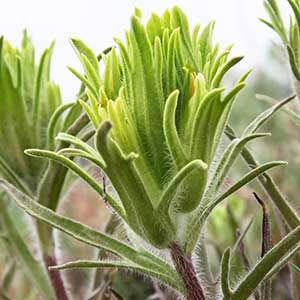Castilleja disticha
Castilleja oresbia
wavyleaf Indian paintbrush
pale paintbrush, pale Wallowa Indian paintbrush, pale Wallowa paintbrush
many, erect, unbranched or branched, sometimes with small, leafy axillary branches, hairs spreading, long, soft, mixed with shorter stipitate-glandular ones.
few to several, erect or ascending, sometimes decumbent at base, unbranched or branched, hairs usually retrorse, medium length, ± soft, eglandular, mixed with very short-glandular ones, sometimes with spreading, long, soft ones.
green or purple-tinged, lanceolate to linear-oblong, 0.8–6.1 cm, not fleshy, margins wavy, involute, 0(–3)-lobed, apex rounded to acute;
lobes spreading-ascending, narrowly lanceolate, apex acute to acuminate.
green to purple, linear to lanceolate, 2–7 cm, not fleshy, margins plane, involute, 3–5(–7)-lobed, apex acuminate to acute;
lobes spreading, linear to sometimes narrowly lanceolate, apex acute.
3–34 × 1.5–3.5 cm;
flowers usually distichous, remote, except distalmost;
bracts proximally greenish, distally greenish, reddish, orange-red, or dull orange, rarely yellow, proximal bracts frequently greenish throughout, lanceolate to narrowly ovate or narrowly oblong-elliptic, 0(–3)-lobed, proximal wavy-margined;
lobes ascending, triangular, short, arising near apex, apex acute to obtuse.
2.5–18 × 1–3.5 cm;
bracts pale green to yellow-green or pale, dull reddish brown throughout, or proximally so colored but changing gradually to cream or yellowish on distal margins, narrowly to broadly lanceolate, (3–)5–7(–9)-lobed;
lobes ascending, linear, long, proximal lobes arising below mid length, central lobe apex obtuse, others acute.
± curved, 25–38 mm;
tube 14–18 mm;
beak and often abaxial lip exserted;
beak adaxially dull orange or dull red, rarely yellow, 14–19 mm;
abaxial lip slightly curved, green, red, whitish, or yellow, not inflated, 2–2.5 mm, 15% as long as beak;
teeth incurved, deep green to reddish, 1–1.5 mm.
straight, 21–36 mm;
tube 16–20 mm;
teeth of abaxial lip often exserted, beak exserted;
beak adaxially green, 4.2–5.5 mm;
abaxial lip green to purple, distally white, conspicuous, slightly but noticeably pouched, often visible through front cleft, 3–5 mm, 67–100% as long as beak, puberulent;
teeth erect, white, 1.8–2.1 mm.
proximally whitish, green, or purple, distally colored as bracts, 9–18 mm;
abaxial clefts 6–6.5 mm, adaxial 7–9 mm, clefts 33+% of calyx length, deeper than laterals, lateral 1.5–4 mm, ca. 10% of calyx length;
lobes linear-lanceolate, apex acute.
colored as bracts, 10–25 mm;
abaxial and adaxial clefts 6–7 mm, 30–60% of calyx length, deeper than laterals, lateral 5–10 mm, 40–50% of calyx length;
lobes linear, apex acute.
= 24.
Castilleja disticha
Castilleja oresbia
Castilleja disticha is limited to the central and southern Sierra Nevada. Although similar to C. applegatei and C. martini, C. disticha is distinctive and unique in its long, colorful, and highly exserted corollas with the beak exceeding the tube in length, calyces more brightly colored than the often unlobed bracts, and tall, strongly distichous growth form.
(Discussion copyrighted by Flora of North America; reprinted with permission.)
Castilleja oresbia is endemic to eastern Oregon and adjacent Idaho. It is easily confused with both varieties of C. pallescens, which also occur in sagebrush habitats. Castilleja oresbia has longer calyx lobes and softer pubescence than C. pallescens var. pallescens, although some transitional specimens are found. Castilleja oresbia has a combination of longer calyx lobes, longer pubescence, and obscurely nerved bracts, which usually serve to separate it from C. pallescens var. inverta. All three have different, though somewhat overlapping, ranges. Castilleja oresbia occasionally hybridizes with C. peckiana in Grant County, Oregon.
(Discussion copyrighted by Flora of North America; reprinted with permission.)


